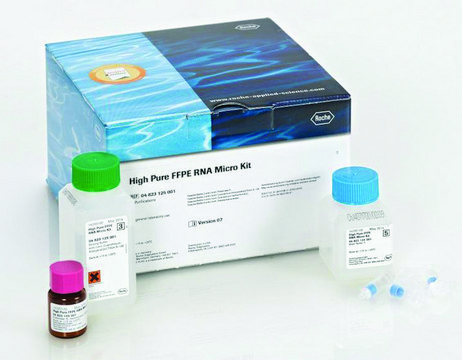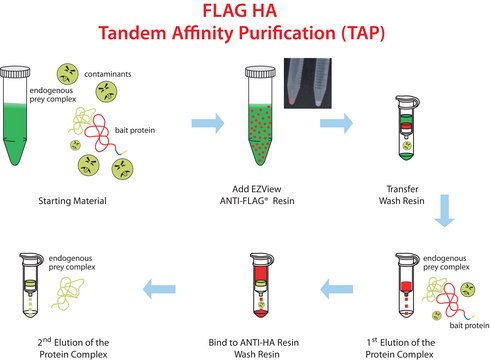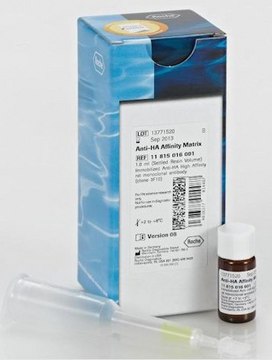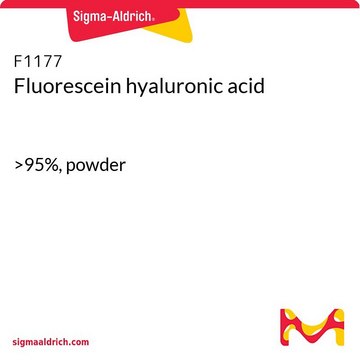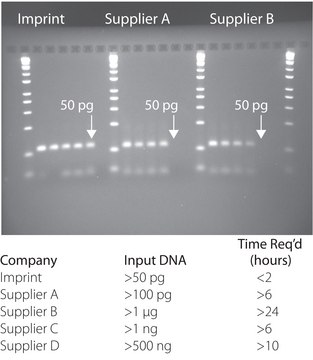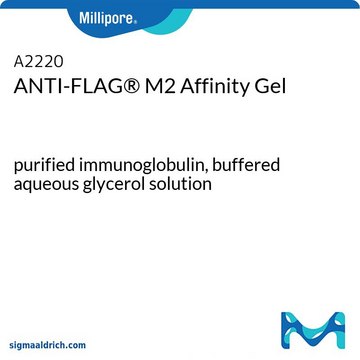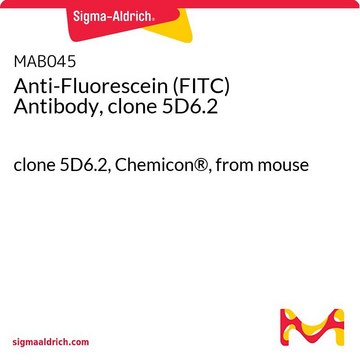11988506001
Roche
Anti-HA-Fluorescein, High Affinity
from rat IgG1
Synonym(s):
antibody
Sign Into View Organizational & Contract Pricing
All Photos(1)
About This Item
UNSPSC Code:
12352200
Recommended Products
biological source
rat
conjugate
fluorescein conjugate
antibody form
purified immunoglobulin
antibody product type
primary antibodies
clone
3F10, monoclonal
form
lyophilized
packaging
pkg of 25 μg
manufacturer/tradename
Roche
isotype
IgG1
epitope sequence
YPYDVPDYA
storage temp.
−20°C
General description
Anti-HA-Fluorescein, High Affinity is a monoclonal antibody for the highly sensitive detection of HA-tagged recombinant proteins, Fab fragments, conjugated to fluorescein.
Anti-HA-Fluorescein, High Affinity recognizes the HA peptide sequence (YPYDVPDYA), derived from the human hemagglutinin protein. The antibody recognizes its antigenic determinant even when the HA peptide epitope is introduced into unrelated recombinant proteins by a technique known as "epitope tagging".
Contents
Lyophilizate, stabilized
Anti-HA-Fluorescein, High Affinity recognizes the HA peptide sequence (YPYDVPDYA), derived from the human hemagglutinin protein. The antibody recognizes its antigenic determinant even when the HA peptide epitope is introduced into unrelated recombinant proteins by a technique known as "epitope tagging".
Contents
Lyophilizate, stabilized
Specificity
Anti-HA-Fluorescein, High Affinity (3F10) recognizes the 9-amino acid sequence YPYDVPDYA, derived from the human influenza hemagglutinin (HA) protein. This epitope is also recognized in fusion proteins regardless of its position (N-terminal, C-terminal or internal).
Immunogen
Amino acids 98 to 106 from the human influenza virus hemagglutinin protein
Application
Anti-HA-Fluorescein, High Affinity has been used in immunofluorescence labeling of chinese hamster ovary live cells and in immunocytochemistry of neuron cell culture.
Quality
The Anti-HA-Fluorescein, High Affinity antibody is function tested by flow cytometry analysis of a HA-tagged fusion protein
Preparation Note
Stabilizers: proteinous stabilizers
Working concentration: Flow cytometry: 1 to 5 μg/ml
Immunofluorescence: 1 to 5 μg/ml
Working concentration of conjugate depends on application and substrate. Concentrations should be taken as a guideline.
Storage conditions (working solution): Reconstituted antibody is stable at 2 to 8 °C for two months. Alternatively store aliquots at -15 to -25 °C for up to six months.
Note: Avoid thawing and repeated freezing.
Working concentration: Flow cytometry: 1 to 5 μg/ml
Immunofluorescence: 1 to 5 μg/ml
Working concentration of conjugate depends on application and substrate. Concentrations should be taken as a guideline.
Storage conditions (working solution): Reconstituted antibody is stable at 2 to 8 °C for two months. Alternatively store aliquots at -15 to -25 °C for up to six months.
Note: Avoid thawing and repeated freezing.
Reconstitution
Add 0.5 ml double-distilled water to a final concentration of 50 μg/ml. Rehydrate for 10 minutes prior to use.
Other Notes
For life science research only. Not for use in diagnostic procedures.
Not finding the right product?
Try our Product Selector Tool.
Signal Word
Warning
Hazard Statements
Precautionary Statements
Hazard Classifications
Aquatic Chronic 3 - Skin Sens. 1
Storage Class Code
11 - Combustible Solids
WGK
WGK 2
Flash Point(F)
does not flash
Flash Point(C)
does not flash
Regulatory Information
常规特殊物品
Choose from one of the most recent versions:
Already Own This Product?
Find documentation for the products that you have recently purchased in the Document Library.
Alfred J Zullo et al.
Journal of immunology (Baltimore, Md. : 1950), 178(1), 58-66 (2006-12-22)
NKT cells are glycolipid-reactive lymphocytes that express markers and perform functions common to both T lymphocytes and NK cells. Although the genetic events controlling conventional T cell development are well defined, the transcription factors and genetic programs regulating NKT cell
Toshiya Ando et al.
Current biology : CB, 29(9), 1512-1520 (2019-04-23)
Nanometer-level patterned surface structures form the basis of biological functions, including superhydrophobicity, structural coloration, and light absorption [1-3]. In insects, the cuticle overlying the olfactory sensilla has multiple small (50- to 200-nm diameter) pores [4-8], which are supposed to function
Enhanced dimerization drives ligand-independent activity of mutant epidermal growth factor receptor in lung cancer.
Valley CC, et al.
Molecular Biology of the Cell, 26(22), 4087-4099 (2015)
A combined transgenic proteomic analysis and regulated trafficking of neuroligin-2.
Kang Y, et al.
The Journal of Biological Chemistry, 289(42), 29350-29364 (2014)
Christopher C Valley et al.
Molecular biology of the cell, 26(22), 4087-4099 (2015-09-05)
Mutations within the epidermal growth factor receptor (EGFR/erbB1/Her1) are often associated with tumorigenesis. In particular, a number of EGFR mutants that demonstrate ligand-independent signaling are common in non-small cell lung cancer (NSCLC), including kinase domain mutations L858R (also called L834R)
Our team of scientists has experience in all areas of research including Life Science, Material Science, Chemical Synthesis, Chromatography, Analytical and many others.
Contact Technical Service
